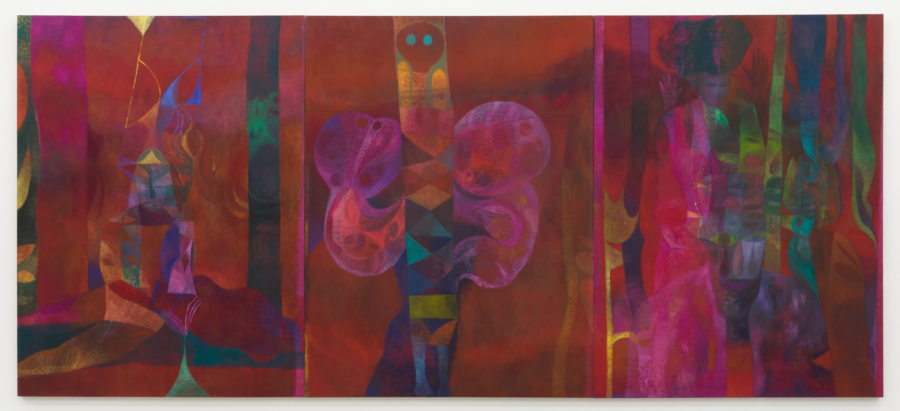October 11, 2023
Download as PDF
View on Contemporary Art Review LA

Maja Ruznic, The Arrival of Wild Gods (2022). Oil on linen in three parts, 100 × 76 inches each, 100 × 228.5 inches overall. Image courtesy of the artist and Karma.
Fractured figures and embryonic masses disappear and resurface throughout Maja Ruznic’s Geometry of Exile, on view at Karma. Squatting bodies, eggs, and breasts multiply across her illusory painted compositions, where imagery related to childbirth and motherhood blossoms within geometric, inchoate fields of red and green. With titles like MOM, March of Holographic Children, and The Split/The Beginning (all 2023), it might seem that Ruznic positions birth as the exile of one self (the child) from another (the mother), resulting in the formation of two, distinct subjectivities. But, rather than highlighting this estrangement, Ruznic explores a more liminal zone of maternal experience, plunging the viewer into an interdependent space characterized by the overlapping boundaries between self and other.
The atmosphere of The Arrival of Wild Gods (2022) stages this encounter of different subjectivities, telegraphing the psychic space of pregnancy. Within the large-scale triptych, human body parts like eyes and hands float within a crimson-soaked, abstracted forest replete with vertical columns resembling birch tree trunks. Ruznic applies many thin layers of oil paint to build her compositions, creating a palimpsestic effect where figures lurk within her shifting shapes. In the middle panel, two fetal forms extend like wisps of smoke from a vertical base marked with quilt-like patterns. Paired with the work’s warm tonality, the uteral imagery conjures the interiority of a mother’s womb. Ruznic emphasizes the fluidity of this space, where figures rupture and reattach into new forms.
Another painter of spectral forms, artist and psychoanalytic theorist Bracha L. Ettinger calls the prenatal womb’s entwinement of self and other the “matrixial sphere”—a space that originates in, but extends beyond, fetal development. The matrixial sphere produces identity through the continuous entwinement of “I” and “not-I,” a corporeal experience where the borders of one self are continually enmeshed with those of another. Self and other connect for Ruznic, too, even as her paintings move past more legible images of birth. The Force Field (2023) features two bleary, elongated humanoids. A ghostly dyad, the figures each bear twin heads emerging from their necks, their contours almost indistinguishable from the patchworked abstraction suffusing the composition. While not blatantly representing the processes of pregnancy and motherhood, Ruznic’s conjoined twins suggest the highly sensory condition of the matrixial sphere, where the gaps between distinct individuals close.
Despite the intimacy of these blurred borders between self and other, Ruznic’s works still possess an unnerving character. Holographic Anxiety Propellor (2023) depicts a central chimeric figure with a grimacing face, an inverted triangular body, and wings. Its mood has thrown its atmosphere into disorder, as frantic lines spread across the canvas like light trails. The self is unrecognizable, lost beneath layers of twisting triangles and radiating curves. The disintegration and reabsorption characterizing the matrixial zone can, at times, be threatening—but it can also be generative. By exploring the interdependence between self and other in motherhood, Ruznic makes space for an expansive conception of subjecthood, one that moves away from complete individuation towards the sustained force of pre-birth enmeshment.
Maja Ruznic: Geometry of Exile runs from September 16–November 4, 2023 at Karma (7351 Santa Monica Blvd., Los Angeles, CA 90046).



